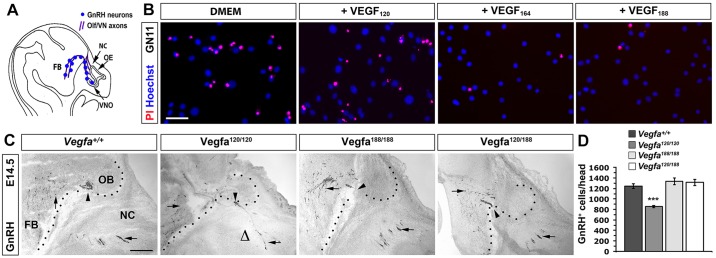Fig. 4.

VEGF188 is sufficient to promote GnRH neuron survival. (A) GnRH neuron migration (blue dots). The neurons are born in the nasal placodes that give rise to the olfactory and vomeronasal epithelia (OE, VNO) and migrate along olfactory and vomeronasal axons (purple, Olf/VN) through the nasal compartment (NC) to reach the forebrain (FB). (B) Serum-starved GN11 cells were treated with DMEM or DMEM-containing serum, VEGF120, VEGF164 or VEGF188; cell death was visualised by propidium iodide staining (red); Hoechst staining (blue) identified the total number of cells. Scale bar: 25 µm. (C) Sagittal sections of E14.5 mouse heads of the indicated genotypes, immunolabelled for GnRH. Arrows indicate migrating neurons; arrowheads indicate blood vessels; open triangles indicate the absence of migrating neurons; dotted lines indicate the FB boundary. OB, olfactory bulb. Scale bar: 100 µm. (D) GnRH neuron number in E14.5 heads of the indicated genotypes (mean±s.e.m.): control, 1246±46, n=6; Vegfa120/120, 854±21, n=5; Vegfa188/188, 1335±63, n=3; Vegfa120/188, 1314±58, n=3; t-test; ***P<0.001 compared with control.
